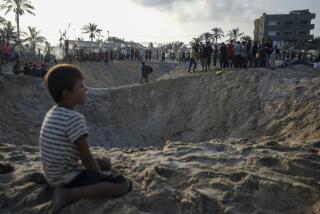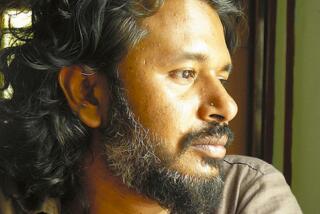India’s Struggle in Sri Lanka Has Just Begun
- Share via
NEW DELHI — What a coincidence that Indian victory over the Tamil militants in Sri Lanka should have coincided with the celebration of one of the most sacred of Hindu religious festivals, Diwali. As the legend goes, it was then that the virtuous King Rama returned from Lanka where he had gone to slay a 10-headed demon, Ravana.
The Indian army may well succeed in defeating the Tamil demons in Sri Lanka. But the victory raises many long-term problems for the Rajiv Gandhi government.
India launched the military operation against the Tamil extremists in August with two objectives: to disarm the most heavily armed and violent of various Tamil organizations, the Liberation Tigers of Tamil Eelam and to secure the latter’s unequivocal acceptance of the India-Sri Lanka peace accord of last July.
Delhi may well achieve the first objective but perhaps not the second.
It is only a matter of time before the Tamil resistence, however well-armed and organized, gives in to the Indian army, one of the best and largest fighting machines in the world. The Indian peacekeeping force, consisting of about 8,000 men, recently captured Jaffna town, the stronghold of Tamil resistance. Even though the contest between the soldier and the guerrilla in Jaffna was heavily weighted in favor of the soldiers, the Indian army has suffered high casualties. In 2 1/2 months, more than 200 Indians and 700 Tamils have died.
It is the second objective, getting the support of the Tamil Tigers for the Indo-Sri Lanka peace agreement, that is crucial for peace. The agreement, at least on paper, puts an end to the four-year-old ethnic conflict between the Tamils and Sinhalese of Sri Lanka. It provides for a referendum in the northern and eastern parts of the country where the Tamils are in majority or in sizeable numbers, a just and democratic solution to the ethnic conflict.
Can the Tamil Tigers really agree to this? Their mercurial leader, Velupillai Prabhakaran, is alleged to have said some time ago that he and his followers were pressured by the Indians into accepting the peace agreement. The Tigers are opposed to the agreement, for they are not sure of winning the referendum. People who have ruled by bullet may not now want to submit to the ballot. By physically liquidating various Tamil organizations and intimidating the people, the Tigers have managed to present themselves as the only spokesman of the Sri Lankan Tamils. Now their claim to popularity has to be tested in the election and they don’t want the test.
It is up to India to disarm the Tigers and secure their consent for the peace agreement. That is the onerous task Delhi has taken upon itself in order to keep peace in the region. The task may prove difficult, for the Tigers have powerful supporters across the Palk Strait, in the southern state of Tamil Nadu.
In the past Delhi has found it difficult to prevent the government of Tamil Nadu from giving arms, money and political support to the Tamil extremists of Sri Lanka. The Indian offensive against the Tigers has provoked great resentment; strikes and demonstrations have been staged in Tamil Nadu.
The Tamil terrorists have other rich supporters. The rich Tamil communities in England, Singapore and the United States have in the past generously funded the Tamil insurrection in Sri Lanka. In recent operations the Tigers have used an array of modern weapons: mortars, rocket launchers, mines and heavy explosives. Obviously they have funds and sources of arms, and these won’t dry up.
The biggest problem facing India is how to obtain the consent of various contending factions and personalties for the agreement. While the agreement is in the best interests of both India and Sri Lanka, that’s not the way most Sri Lankans see it. Except for the most pro-Indian among Sri Lankan politicians, President Junius R. Jayewardene, the agreement appears to most Sri Lankans as outside intrusion, an Indian diktat.
Thus Delhi’s main ally is a Sri Lankan president who narrowly escaped a recent assassination attempt. Two Indian frigates are stationed outside Colombo, presumably for his security.
Peacekeeping is a precarious task, particularly when there are few takers of peace. One then wonders why Jayewardene rushed to sign the agreement with Rajiv Gandhi last July without first creating a consensus for it at home. This wily politician has been in the rough and tumble of Sri Lankan politics for too long not to know how difficult it is to manage the island democracy. Speculations as to why he so suddenly agreed to make peace with India vary: an impending army coup and therefore the need for Indian protection, belated realization that he has to deal with a militarily superior India, American pressures or good sense.
Whatever the reasons, Delhi has no other choice now but to fully back the Sri Lankan leader, and this means deeper Indian involvement in the murky domestic politics of its southern neighbor.
Military strength alone is never sufficient to handle such situations. Just a right mix of cajolery and coercion, reward and punishment, is needed to get a small country to agree to the regional scheme of a regionally dominant power.
The Indian predicament in Sri Lanka is somewhat similar to the American one in Lebanon. In 1982 the United States went into Lebanon to keep peace between the Muslims and the Christians; in the process it ended up supporting the Amin Gemayel regime, which had no popular basis. The task was too onerous and Washington finally abandoned it.
India today has chosen to underwrite the Jayewardene government. The venture may not succeed, and in any event it will cost Delhi dearly in money and blood to fulfill a long-nurtured ambition to be the guardian of peace in South Asia. Peace between the two democracies, India and Sri Lanka, is indeed desirable and the agreement provides the basis for it. The question is whether India could have gone about it differently.
More to Read
Sign up for Essential California
The most important California stories and recommendations in your inbox every morning.
You may occasionally receive promotional content from the Los Angeles Times.










